[0015]An embodiment of the present invention relates to systems, methods, and computer products that efficiently determine how columns, tables, and queries associated with a database are related to each other. Further, by operation of the present invention improving the determination of how columns, tables, and queries of relational or multidimensional databases are related to each other, users can navigate quickly between different views of database information, such as query information. Techniques of the past have not been able to efficiently determine how columns, tables, and queries associated with a database are related to each other.
[0016]The present invention improves the analysis of
metadata in a database. The present invention enables a user to take
advantage of
heuristics for OLAP
processing of data.
Heuristics are defined herein as user-specific criteria, such as a set of rules, intended to increase the probability of solving a problem associated with a database. The preferred embodiment of the present invention employs a query miner module to analyze query objects based on
heuristics that are embodied in
SQL statements. For instance, the query miner module may identify and rate queries according to their level of satisfaction of
heuristic rules, and show statistics associated with the result of the queries. In one embodiment of the present invention, the query miner module may collect information about the frequency of combinations of table and column information associated with a query so that the user may assess the relationship between the tables and columns of data in a database. Further, the results of searches driven by
heuristic rules may be analyzed and reported in a variety of ways that may be used to generate additional user-specific
heuristics. For example,
heuristic rules may be based on information about various owners of the data, the last used data, or key words in
SQL statements. Alternatively heuristic rules may be based on all search fields in the
SQL statement. The
metadata information about attributes associated with a query, such as tables and columns, and the result of statistical information about the data that is based on heuristic rules, advantageously enables a user to determine useful relationships and attributes, such as dimensions, from a database. The terms “dimension” and “views” will be used interchangeably herein.
[0017]The present invention allows easy browsing of queries, tables, and columns, and enables a user to see at a glance in which queries certain columns and tables are used. The present invention may be implemented with a query browser module that improves browsing through queries and their components over the past. The preferred embodiment of the present invention provides an easy to use graphical interface showing query objects associated with queries, tables, and columns in a
tree structure. Further, the preferred embodiment of the present invention operates efficiently and presents information about columns, tables, and queries to the user without discernable
lag time between the user's request and the generated information.
[0018]According to the preferred embodiment of the present invention the table and column information is complete thereby ensuring accurate browsing. Therefore, data collection associated with browsing, such as browsing
metadata, and in the preferred embodiment of the present invention is performed against all queries by the query miner module.
[0019]An embodiment of the present invention is achieved by systems, methods, and computer products that improve the determination of useful relationships and dimensions associated with a database when employing OLAP
processing techniques; and that improve the determination of how columns, tables, and queries of a database are related to each other. The method comprises: (a) creating and propagating a database; (b) executing a query object with the query miner module that may operate in conjunction with the product marketed under the
trademark IBM QMF (Query Management Facility) and that is directed to a database; this execution further includes (i) applying user-specific heuristics as rules used by the query miner module via the query object; (ii) applying a data-mining statistical tabulation against the data in the database and metadata associated with the database and therefore collecting statistical information about the query
object based on the user-specific heuristics; and (iii) determining useful information by analyzing the statistical information; (c) retrieving at least one view of the statistical information that satisfies the user-specific heuristics; (d) rating the statistical information that satisfies the user-specific heuristics; and (e) presenting the rated statistical information, such as views of table, column, or query information as a user-specific report; the presentation further includes (i) determining if the user wants to use new heuristics and if not; (ii) optionally creating at least one user-specific report and exporting the user-specific report to final report documents, such as
XML files; and (iii) if the user wants to use new heuristics repeating the process of executing a query object.
 Login to View More
Login to View More  Login to View More
Login to View More 


